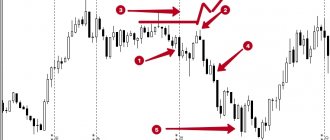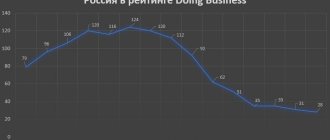About the book “Technical Analysis. Course for Beginners”
Book “Technical Analysis. Course for Beginners" will be an excellent assistant for novice traders and investors. In the modern world, more and more people are interested in trading on currency exchanges, are interested in the securities market, various financial instruments, and are engaged in investments. Of course, no one will do all this thoughtlessly, especially since the investments required are quite large, no one will want to risk such a sum. You can also get a lot of income. This is why books like this are so popular.
From this manual you can glean a lot of useful information, understand different terms, and understand how to act. The main theme of the book is financial market analysis. Thus, based on price dynamics, it will be possible to draw certain conclusions and predict changes.
The book tells how to use the proposed methods in practice, how to navigate the situation, relying on various indicators. There are many real examples with graphs and their explanations. The book will be useful for anyone interested in trading and investing.
On our website you can download the book “Technical Analysis. Course for Beginners” for free and without registration in fb2, rtf, epub, pdf, txt format, read the book online or buy the book in the online store.
To the readers
Dear Sirs!
We are pleased to present to you our new project - the publication of a series of textbooks for students of Russian economic universities and aspiring specialists in the banking and financial sector.
This project is a continuation of a large educational program to train qualified personnel for financial institutions and markets in Russia and the CIS countries, which has been carried out over the past 7 years.
Today it is the world's leading organization for the dissemination of news and financial information. In 2001, the company celebrated its 150th anniversary.
Reuters is unmatched in the volume, complexity and overall volume of information it supplies to banks, the media and a growing number of other business subscribers.
All of the world's leading banks, brokerage firms and financial institutions use this information for trading, large companies use it to study markets and competitors, and the world's media use it to create printed materials, television and radio programs.
We hope that our manuals will be of interest to you and this will be the beginning of a fruitful cooperation with.
Sincerely,
Ricardo Torres,
CEO of Reuters AO
Description
Program
Lesson 1. Introduction to technical analysis (January 11 at 20:00)
- The basis of technical analysis
- Types and types of graphics
- Choosing a time frame for decision making
- Identifying trends in a graph
Lesson 2. Resistance and support levels (January 13 at 20:00)
- Types of support and resistance levels
- Rules for building levels
- Types of level breakdown
- Trend channel
Lesson 3. Overview of the TradingView analytical platform (January 15 at 20:00)
- How to register
- How to set up charts
- What tools to use
Lesson 4. Figures of graphical analysis (January 18 at 20:00)
- Trend reversal patterns
- Double top and double bottom
- Head and shoulders
- Continuation Models
- Triangle figure
- Model Flag
- False chart patterns
Lesson 5. Trend indicators (January 20 at 20:00)
- Indicator analysis
- Moving Average
- MACD
- Bollinger Bands
Lesson 6. Oscillators (January 22 at 20:00)
- Oscillators in technical analysis
- Relative Strength Index (RSI)
- Stochastic Oscillator
- Overbought and oversold
- Crossing the midline
Start date
Technical analysis for beginners is a headache. You can and should study it endlessly, throughout your entire work related to trading. If you choose this path, then you need to constantly improve.
The work is quite hard and requires diligence. Endless charts, numbers, various additional tools, programs, robots and much more - all this is technical analysis. A course for novice traders should contain at least the basics, namely: Japanese candlesticks, trend lines, support and resistance, the simplest indicators, the concept of a time frame and some other things.
What is technical analysis
First, a short theoretical excursion into technical analysis so that you can understand whether you need knowledge from this area of exchange trading.
Technical analysis is a technique that allows you to find and analyze trends in price changes for various assets over a period of time (hour, day, month, year, etc.). Based on the identified trend, the trader predicts further development and makes an informed decision on buying or selling an asset.
Many beginners lose their capital when they make transactions in the stock market against the backdrop of emotions, unfavorable analyst forecasts, bad economic news, or under the influence of the mood of the majority of players. But a professional investor makes a decision only on the basis of fundamental and technical analysis.
The latter is carried out by studying stock charts, of which several dozen have been developed to date. But the most popular are:
- Linear.
- Bar chart.
- Japanese candlestick chart.
They use analysis of trends, patterns and technical indicators. You can read about all the methods, methods and techniques of technical analysis in the top 10 books that I have selected for you.
What is technical analysis
Technical analysis is the study of prices in the past to predict them in the future using various tools: indicators, graphical figures, etc. It does not answer the question “why did the price change?”, but only shows the most likely price change based on the market behavior for past period.
The market clearly illustrates the flows of supply and demand, which reflect the hopes and opinions of people and shape their behavior in the market. Based on this, technical analysis should use price movements and indicator signals, implying that their movements will be repeated in the future.
It answers the main question for a trader – whether it is worth buying, selling or not making transactions with the selected asset now. It is used by both speculators and investors. A speculator can rely entirely on technical analysis. In this case, the investor makes a decision to purchase an asset based on fundamental analysis, and uses technical analysis to buy (and then sell) the asset at a better price.
Technical analysis is based on three basic postulates.
- The market price takes everything into account. According to this axiom, all the information necessary to make a trading decision is already taken into account in the price chart and trading volumes. It is assumed that the price reacts almost immediately to all events that can affect it.
- Price movements are subject to trends. The market periodically appears trendwhich continues for some time. It can be rising or falling, depending on the relationship between supply and demand for the asset. If there is a trend, periods of opposite price movement may occur ( correction).
The trend can end at any time, that is, it is finite. At the same time, a situation without a trend is possible in the market, which is called sideways movement ( sideways , flat ). In essence, this is a horizontally directed price movement over a long period of time. - History repeats itself. If price has moved in a certain way in certain situations in the past, then there is reason to believe that in the future, in the same situations, the price will react in a similar way.
The price chart is the most objective indicator of the functioning of the securities market. All technical indicators and models are based on 5 numbers displayed on the chart.
These numbers correspond to a specific time interval (for example, take 1 hour):
- opening price – the price at which trading begins at this hour
- closing price – the price of the last trade for this hour
- maximum price – the highest transaction price within an hour
- minimum price – the lowest transaction price within an hour
- trading volume – number of transactions per hour
At the end of the 19th century, the founder of The Wall Street Journal, Charles Dow, published a series of articles about the securities market, which served as the beginning of the development of technical analysis. The Dow Theory is based on six principles. We will look at 4 main ones.
- There are three type of trends depending on their duration: - primary (long-term); — secondary (intermediate, medium-term); - small (short-term). Each type of trend, in turn, can be ascending or downward. According to the Dow Theory, in an uptrend, the position of each subsequent peak or trough should be higher than the previous one. The opposite picture is with a downward trend.
- A long-term trend is characterized by three phases: The first is the accumulation phase. During this phase, experienced investors begin to buy (sell) stocks contrary to the general market opinion (in other words, this phase is preceded by a countertrend or sideways trend). This stage does not last long and is not accompanied by strong price changes. The second is the Participation Phase. At the beginning of this phase, so-called active traders, using technical analysis, catch the beginning of a trend, which was started by investors with large capital. By making transactions, active traders strengthen the trend, which is accompanied by a strong price change. The third is the Implementation Phase. At the last stage, all market participants understand the current trend. Thus, at the beginning of this phase, a fairly large part of traders open positions in the direction of the trend. At a certain point, astute traders anticipate the end of a trend and initiate a price reversal process, closing their positions at a profit.
- The trend must be confirmed by trading volume. Based on the Dow theory, trading volume is a mandatory indicator of the presence of a trend. If the price changes with a small trading volume, then there is no trend as such, since it does not reflect the opinion of the majority.
- The trend is valid until a clear signal appears about its termination. In an uptrend, a temporary decrease in prices can act as a trend correction. To reverse the trend, it is necessary to generate stronger technical signals (technical analysis signals).
Price chart
The flow of data on exchange transactions can be presented in the form of a price graph , that is, a time-varying line, each point of which reflects information about the price and time of each individual transaction.
Such a graph has the usual linear form and is ticked according to the time interval of construction (from the English tick - ticking, instant). The tick chart reflects data on absolutely all completed transactions. It shows every price change, but due to information overload, the possibilities for its analysis are significantly limited. This is especially true for liquid securities, the number of transactions for which reaches hundreds of thousands in one trading day. Even a powerful computer will find it difficult to process such a large amount of data. But the most important thing is that the information content of technical analysis indicators will become quite low.
In order to optimize the process of graphical analysis and be able to make decisions in accordance with the chosen trading pace, data on prices and trading volume are usually plotted on the chart not as a continuous stream, but in accordance with the selected time interval - timeframe . For example, in the case of an hourly timeframe, the step on the horizontal axis of the chart is one hour.
In each time period of the timeframe, the 5 most significant price values are highlighted.
- Opening price : the price at which trading begins
- Closing price : last trade price
- Maximum price : highest transaction price
- Minimum price : lowest transaction price
- Trading volume : number of transactions for the selected period of time
The most important indicator of the five listed is the closing price of the period, since it is the final consensus of sellers and buyers on the price of the asset for the period.
Therefore, when constructing a simple line chart for a certain time frame, instead of the entire stream of price data, it will display exactly the closing prices of the selected time interval. Data on the opening of the period and the minimum or maximum price for the period are not taken into account on the line chart, which makes it uninformative for the trader.
This drawback can be eliminated by using another type of graphical representation of data that is different from linear: Japanese candlesticks.
A Japanese candlestick is constructed as follows: the minimum and maximum are connected by a vertical line, and between the opening and closing prices a rectangle is constructed, colored in one of two colors, depending on whether the candle was rising (white, green) or falling (black, red).
The rectangle of the candle connecting the opening and closing prices is called the body of the candle. The vertical lines between the body and the high (low) are called shadows or tails of the candle.
To build a volume chart and charts of some indicators, a specific type of chart is used - histogram . The histogram represents bars corresponding to the value of the estimated parameter.
Timeframe
As mentioned earlier, the open, close, low, high and volume are plotted on the price chart in accordance with the selected time frame.
In technical analysis, standard timeframes are mainly used:
- 1 minute
- 5 minutes
- 15 minutes
- 1 hour
- 4 hours
- 1 day
- 1 Week
- 1 month
It is at these time intervals that the basic principles of technical analysis are successfully implemented, since they are used by the majority of market participants. However, there are technical analysis programs that allow you to build charts with non-standard time frames.
The importance of choosing the right timeframe is determined by two factors:
- the time frame determines the pace of trading that the trader will adhere to when analyzing the chart on the selected time interval;
- The time frame makes demands on the trader regarding the degree of involvement in the market.
The figure shows charts of the same security for the same period (indicated by the circled areas), but with a different time frame. What looks like one growing candle on the daily chart, looks like a short growing trend on the hourly chart, and turns into a full-fledged intraday trend on the 15-minute and 5-minute charts.
Thus, on lower timeframes (relative to the daily one), growth and correction phases are visible, which allows you to analyze the chart for an informed decision on a transaction.
The correspondence between the trading pace and the standard timeframe for chart analysis is given in the table.
Please note that you first need to find the expected trading pace in the right column, then select the corresponding time frame in the middle column, and finally assess whether you can follow the rules of chart analysis on a given time frame.
There are two rules to follow.
- You need to track every new candle, that is, for a time frame of 15 minutes you will have to monitor the market every 15 minutes, for 1 hour - every hour, and so on.
- When a signal to execute a transaction is received, it must be completed no later than the close of the next candle. That is, having received a signal for a trade on the 15-minute chart at the close of one 15-minute candle, you must make a decision and make a trade no later than the next one is finally formed. Thus, you have only 15 minutes to decide and implement it.
The timeframe chosen in this way is the main one for your trading strategy, and the decision-making system is built for it. If you subsequently decide to change the main time frame, the system may change completely, since different trading principles are relevant for different time intervals.
An important point: when working with the selected time frame, you can use higher charts to support your analysis. However, the transaction is executed based on the chart with the main timeframe.
Types of Trends
Most of the time, prices move in a direction, and the direction is determined by market participants.
The price chart can be in two phases: trend or sideways. A trend can be rising or falling, while a flat is characterized by a lack of direction of market movement and a slight change in prices.
The behavior of most indicators and models differs for a trend and a flat, so one of the main tasks of technical analysis is to determine the presence and direction of a market trend.
A growing trend is characterized by a sequence of rising highs. This means that each local maximum is higher than the previous one.
The situation is the same with local minima of a growing trend - they are ascending.
The market's failure to overcome the previous high indicates a weakening trend and is an early warning of a reversal. Any fall below the previous low signals a completed reversal and the beginning of a downward trend.
If a growing trend failed to consolidate above the previous high, but did not close below the previous low, we can say that the market is entering a sideways movement.
Local minima and maxima of a falling trend form a downward trend. The market's inability to close below the previous low, and then a successful attempt to overcome the previous high, indicates a reversal of the downward trend.
By analogy with an upward trend, if the market closes above the previous low, but cannot overcome the previous high, the market enters a trading range, and the downward trend gives way to a flat.
Depending on the presence or absence of a trend in the market, a technical analyst faces different tasks in analyzing price information.
In a trending market, you first need to get answers to the following questions:
- To what price levels can the current trend continue? The answer to this question allows you to assess the potential profitability of the position being opened and helps you decide on the advisability of opening it.
- To what price levels can the market correct without changing the trend? This sign allows you not to exit open positions prematurely and distinguish between a change in trend and a correction within the existing trend.
- What is a sign that a trend is ending? The ability to timely close open positions and obtain the maximum possible profit in a transaction.
For flat you need:
- Identify the signs and boundaries of a flat.
- If possible (sufficient width of the trading range), make transactions at the boundaries of the flat - buy at the bottom and sell at the top.
Reuters “Technical analysis. Course for Beginners”
The authors are specialists from the financial agency Reuters. This is a complete training course on trading starting from the very basics. Written in simple and accessible language. The book provides just basic knowledge, without the nuances of all analytical tools. After reading it, you can move on to a more detailed study of technical techniques.
The first chapter gives the history of technical analysis and its comparison with fundamental analysis. The second part discusses the types of graphs and practical exercises for constructing them. Then the authors teach classical trend analysis and analysis using indicators.
Of particular value for beginners are practical tasks to consolidate the material.
Complete information about current strategies that have already brought millions of passive income to investors
Jack Schwager “Technical Analysis. Full course"
More than 800 pages of valuable information for professionals and beginners. For many traders, this book comes first. The author is a world-renowned practicing trader. The book is truly a complete course in technical analysis.
The main emphasis is on graphical analysis. All types of graphs and graphical models are presented. The examples are taken from the real practice of a trader. At the end of the book there are examples of original trading systems and step-by-step advice for practicing investors.
The material presented should not be taken as a guide to action. The book was written in 1996. Much has changed since then, including the development of computer technologies in market analysis. But it can definitely be used as an encyclopedia on technical analysis.
Where is technical analysis needed?
It can work almost anywhere: currency, derivatives and stock markets, resources, commodities - in general, any data plotted on a chart. Why is it needed? To predict future price behavior. For example, if you take the euro/dollar currency pair and data on it for a certain period, then based on them you can build a forecast of price behavior in the future. It makes no fundamental difference which trading instruments you work with: futures, options, or even - your assistant.
Determines the actual cost of an investment. Identifies long-term investment opportunities. Disadvantages of fundamental analysis. Over-exposure to macroeconomic indicators can be confusing for the novice investor. Technical analysis is one of the most important tools for predicting the behavior of financial markets. Technical analysis has been created as an effective tool for investors and is being used by an increasing number of players in the market. When used in conjunction with fundamental analysis, technical analysis can offer a much more comprehensive assessment of a situation, which can ultimately lead to profitable trades.
Pros and cons of TA
This understanding of technical analysis determines its main advantages and disadvantages.
The advantages of the method include:
- Universality
- the same approaches and mathematical apparatus can be used for any markets and assets - stock trading, transactions on the Forex market, working with binary options and futures contracts, etc. - Volume of actual data
- analysis can be carried out on the entire available history of a trading instrument, allowing you to obtain the most viable models that work for a long time. - Diversity of tools
- any available methods can be used to process data, from strict mathematical relationships to probabilistic and other tools, for example from the field of statistics, neural network theory, etc. - Ease of use
- after developing the appropriate calculation algorithms, almost every trader can apply them and use the results of their work. - Accuracy - only actual data is used in the work, broadcast in real time or with low latency.
Significant disadvantages of technical analysis:
- When interpreting analysis results, it is impossible to get rid of subjective factors
- each trader makes his own conclusions. - Over time, the behavior of the masses of bidders undergoes changes, due to which some models lose their relevance
and new ones appear. - As a result of technical analysis, we can only talk about the probability of events
, but it is impossible to say that such price behavior will certainly take place.
In addition, we must not forget that the increasing complexity of algorithms and analysis methods requires the use of powerful computing systems, and the accuracy and efficiency of information flow are of paramount importance.
Forex technical analysis
Not long ago we covered the basics of technical analysis. TA is the preparation of a price forecast based on changes in previous quotes. Every event that once influenced the price of an asset - political or economic - has already been taken into account and included in the price.
There are three rules of technical analysis:
- everything is included in the price;
- the course always has a direction (up, down and lateral movement);
- it once was.
The rules are displayed on the chart and most traders in their work rely specifically on TA, which is necessary to make a pricing forecast for exchange and over-the-counter trading.
Before you start...
Who is this book written for?
This book was written to introduce the methods of technical analysis to a variety of groups of readers: traders, back office employees, teachers, managers, private investors seeking to learn how to use technical analysis to implement trading strategies. Anyone starting to study technical analysis can use this book as a foundation. Technical analysis is not an easy discipline, so readers of this book may need to read many more books in the future.
Despite its complexity, technical analysis is no longer just a tool for investment experts. With the advent of publicly available sources of historical market data (such as Reuters) and the ability to access markets via the Internet, technical analysis is becoming relevant for all market participants.
This book will give you an understanding of the basic principles of technical analysis, from the creation of the first charts to the concepts that underpin complex analytical tools. After studying the book, you will learn to use the basic methods of analysis and choose the most appropriate ones in each specific case.
You will also be able to apply your knowledge to study or work in technical analysis at ACI.
What will you find in this book?
This book provides a new approach to gaining basic knowledge of the basic concepts of technical analysis, which continues to grow in importance in modern life. The book is written in accessible language, it contains a minimum of special terms and gives their clear definition.
It is especially valuable that the book provides an opportunity to consolidate the material studied. Each section contains an explanation of basic concepts with practical examples. Exercises and short tests will help you consolidate what you have learned. Each chapter includes a brief but thorough overview and a list of recommended readings on the topic under consideration.
Steve Nison “Japanese candlesticks: graphical analysis of financial markets”
A book on candlestick analysis, which is actively used in the East and has become no less popular in the West. Japanese candlesticks are one of the technical analysis techniques in which the chart is presented in the form of rectangles. Its four points are the opening and closing prices, minimum and maximum. Each candle represents a separate time period. Its shape, the patterns that the candle forms with other elements, allow us to predict the further movement of the trend.
S. Nison teaches how to read candlestick charts. This skill will be useful for both traders on the Forex market and players on the stock exchange. Before Steve, there was no analytical literature in the West that would describe in detail the essence of the method. While eastern traders actively used it. Today Japanese candles are popular all over the world. To some extent, thanks to the book by S. Neeson.
Fans of Japanese flavor will appreciate the section titles. For example, “Dark Cloud Curtain”, “Shooting Star”, “Harami Cross”, etc.
Anna Erlikh “Technical analysis of commodity and financial markets”
Unfortunately, there are very few books by domestic authors on technical analysis. This is one of them. There is a lot of theory in foreign publications, so the most valuable thing in this book is its applied nature. The author presents many diagrams, graphs, and drawings. In this form, information is perceived much easier by beginners.
The main idea is the impossibility of using computer technology to analyze the market. The human brain is capable of drawing more intelligent conclusions from the analysis of the past than a computer.
The author begins with the history and basics of technical analysis. Moves on to a description of the types of financial market charts and classical figures. The book is definitely suitable for improving your skills and reaching a new level in the development of trading skills.
Books on technical analysis
To have a good understanding of technical analysis, you need to read more than one book. Fortunately, there are a lot of them as of 2018.
I recommend reading the following books:
- Technical analysis of futures markets: theory and practice (author John Murphy);
- Technical analysis. The Complete Course (by Jack Schwager);
- Technical Analysis from A to Z (by Akelis Stephen);
- Stock Exchange Secrets (by Linda Raschke);
- Technical Analysis (by Michael N. Kahn);
- Intermarket Technical Analysis (by John Murphy);
- Tic-tac-toe graphical analysis method (by Thomas Dorsey);
- Small Trader's Encyclopedia (author Eric L. Nyman);
- Trading Chaos (by Bill Williams);
- A Primer on Day Trading (by Lewis Borsellino);
Watch also the video about technical analysis:
Types of charts
In fact, there are not many of them. The most popular option is Japanese candles. By the way, they appeared even before trading, exchanges and the Internet in general were born. The second option is bars. These are stripes with dashes. They are somewhat similar to candlesticks, but have a different appearance, although they show the opening and closing prices in the same way. There is a simpler option that beginners love, but it is practically useless. This is a regular line. You can’t really see anything on it; it’s almost impossible to track any technical analysis figures; at most you can understand the current direction of the price. Nevertheless, any options have the right to life. There are other more exotic types of charts, but they are unpopular.
A. Elder “How to play and win on the stock market. Psychology. Technical analysis. Capital control"
Probably the main idea that is worth taking away from A. Elder’s book is that the basis of successful stock trading and investing is psychology. The author pays a lot of attention to psychological aspects. The first 2 chapters one way or another talk about trading through the psychology of a person and the crowd.
Chapter 3 – classic chart analysis: construction, support and resistance, trends and trading corridor, trend lines, breaks. Graphic models are discussed in detail. Chapter 4 is devoted to the role of computers in stock trading. Chapters 5 and 6 – market indicators. Control of emotions is control of risk. A. Elder devoted the 10th chapter to this issue. At the end of the book there are practical problems with answers and points for self-assessment.
Some readers rightly note that financial markets are changing, and A. Elder's material is becoming outdated. This is certainly true. But once again I want to draw your attention to the fact that for novice traders the issue of psychology will always be especially relevant. Ignoring psychological factors in stock trading can lead to loss of capital. The author in the book focuses on this.
Timeframes
Many people will be put off by such a complex foreign name. Nevertheless, without this it is impossible to understand. In your broker's terminal or on a third-party resource, each asset has its own periods for displaying information. Namely:
- 1 minute (M1).
- 5 minutes (M5).
- 15 minutes (M15).
- 1 hour (1H).
- 4 hours (4H).
- 1 day (1D).
Depending on your service provider, these periods may be slightly different, but the above are the most generally accepted and used today. It is advisable to read about the relationship between these periods and understand that the younger ones shape the older ones. So there is no way without this.
Gerald Appel “Technical Analysis. Effective tools for the active investor”
J. Appel is the developer of MACD, one of the well-known technical indicators that has not lost its relevance to this day. The author did not set out to write a complete course on technical analysis. He pays more attention to his original developments and shows the possibilities of their application in practice. A novice trader will find in the book a selection of indicators that have proven their effectiveness, which will help protect them from fatal mistakes.
The author's experience is invaluable. He is a successful trader who has spent his entire life researching and managing money. J. Appel believes that a successful trader is not one who follows the trend and the crowd, but one who is ahead of them and acts independently. His book will allow such people to achieve better results.
The material is useful for both professionals and novice investors. The author shares his favorite methods for selecting securities right from the start. Then he moves on to technical analysis tools to monitor and predict market behavior. And, of course, there are many practical examples and calculations.
Next comes more specialized technical tools and training in the use of trading channels using moving averages. As a developer, J. Appel could not ignore his MACD indicator in the book.
This book is about the most effective tools for choosing the timing of transactions in the stock market, which the author has accumulated over 40 years of his practice.
John Murphy “Visual Investor. How to identify market trends”
Author of several best-selling books on trading. This book was written for those who are taking their first steps in this activity. J. Murphy teaches how to read graphs correctly and compare them without complex formulas. And as a result, make informed and effective investment decisions.
In Chapter 1, the author explains what visual investing is. This is a simple technique that will allow even a beginner to analyze the market. Then he moves on to the concepts of trend and types of charts and graphic models. Part 2 is devoted to indicators. Much attention is paid to such popular instruments as mutual and exchange-traded funds.
Those who are frightened by mathematical formulas and algorithms of higher mathematics will find a lot of value in the book from a professional with a capital P.
Indicators
This is already more complicated. Technical analysis for beginners is not an easy thing. And when it comes to various graphical indicators, it becomes even more difficult. The following are the most popular indicators:
- Relative Strength Index (RSI).
- Stochastic oscillator.
- MACD.
- Bollinger waves.
Each of them has its own tasks, so it is recommended to study each separately. Try looking for information about these indicators separately or use the help that brokers often offer in their platforms. These tools are often used in trading strategies, but there are countless of them in various combinations and variations.











